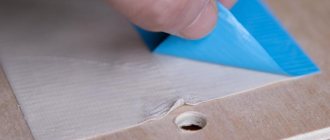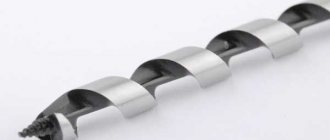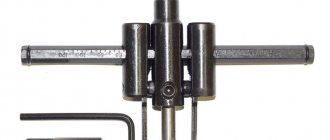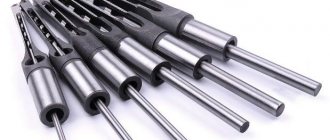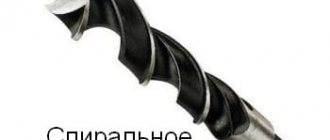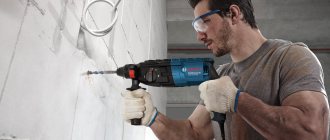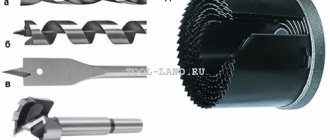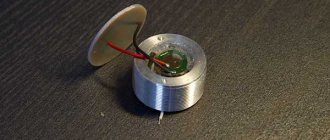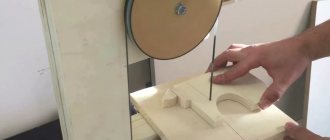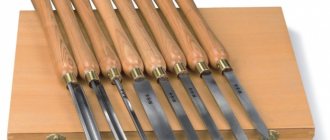Due to its association with the movements of a dancer when performing an operation, a ballerina drill is a type of drilling tool used to produce holes with a diameter of 30 to 400 mm in various materials and round-shaped parts. The technical name is an adjustable type circular drill with cutters. Produced by manufacturers in several modifications depending on the material for which the product is intended. With its help, holes are made in wooden and metal blanks, chipboard, MDF, plywood, plasterboard, fiberboard, tiles, and plastic. The rotation of the tool is carried out at medium or low speed with a drill, rotary hammer or drilling machine.
What is a wood ballerina
A circular adjustable ballerina drill is a device that is designed for drilling round holes of large diameter. The tool has a simple design. It consists of a shank with a transverse rod on which movable carriages with cutters are attached. The rod has markings according to which you can set the required spread of the cutters relative to the center of the intended hole. A core drill is fixed in the middle of the shank. It serves as a centering element and support when drilling.
In addition to designs with two cutting elements located symmetrically, there are ballerinas with one cutter or even three. In the latter case, they are located on the base in the form of a disk with grooves.
Adjustable tool overview
Ballerina – adjustable drill. One of its structural elements is a bracket with a scale printed on it. With its help, you can independently set the required diameter. And in a three-cut drill, the cutting elements move synchronously along special grooves.
Before starting work (drilling), it is necessary to set both cutters at the same distance from the central hole.
Tool functionality
A high-quality ballerina is made of high-strength steel, which makes it possible to use the device in working with soft and hard wood.
This tool has an adjustable drilling diameter. This allows you to make holes of almost any diameter. The limitation of the drilling range depends on the size of the ballerina. Manufacturers produce devices with the following cutter spread limits:
- from 30 to 120 mm;
- from 40 to 200 mm;
- from 40 to 300 mm;
- from 40 to 400 mm.
The maximum drilling diameter is limited by the rod on which the cutters are mounted. The minimum is the thickness of the shank.
A ballerina drill can be used in any places where using a jigsaw or a hand router would be inconvenient. For example, this may be assembled and installed furniture, in the part of which it is necessary to drill a neat hole, given the limited space. Another example is an uneven (concave or curved) surface. It’s unlikely that you’ll be able to do everything smoothly and neatly with a jigsaw or milling cutter. It will be difficult to control the inclination of the tool relative to the surface. A ballerina can easily cope with this task.
Other tools used for the same purposes
Craftsmen can use several more tools to produce large-diameter holes. When drilling wooden surfaces (the diameter of the required hole exceeds 25 mm), you can use a Faustner drill.
Unlike a ballerina, it has a number of disadvantages:
- A large contact area with the working surface is accompanied by strong heating of the drill.
- It is difficult to align the central tip with the applied markings, because only the outer circle with the working incisors is visible.
- The Fostner drill bit is primarily intended for drilling blind holes (to hide the head of a nail if necessary).
- High price (due to the high heat resistance of the drill).
A hole saw is useful for drilling large diameter holes in hardwood, drywall, brick, and laminated surfaces. Some models of this tool are adjustable; you can set the required diameter yourself. When drilling hard surfaces (stone, porcelain tiles, concrete, tiles), you can use crowns. However, they are already produced with a given diameter. And the master has to buy several pieces of crowns or even a whole set. Such financial costs are not always justified. In addition, when working with crowns, a lot of fragments and construction dust are formed. Therefore, drilling using crowns in an already finished and furnished room is impossible.
Features of working with the tool
The principle of working with a circular drill is simple. A hole is drilled using a centering drill, and then the cutters are put to work. They gradually make a narrow groove, gradually cutting through the material in a circle to the full depth.
The materials used in working with the ballerina are varied: wood, fiberboard, chipboard, MDF, plasterboard, plastic. One common point is that the thickness of the part should be no more than 15-20 millimeters. This parameter is limited by the length of the incisors. Usually the manufacturer indicates the maximum drilling depth on the packaging. If you try to drill into thicker material, you may experience problems with ragged edges.
The use of a tool with one cutter is characterized by runout. This is caused by a lack of balancing relative to the longitudinal axis of the drill. The beating will be especially noticeable when cutting large diameter holes. Cut holes using a drill at low or medium speed. When working on a drilling machine, such problems do not arise.
Also, a laminated or veneered surface can cause inconvenience when working. After passing through the decorative layer, drilling proceeds without problems.
A feature of the circular drill can be considered the ability to adjust the diameter. The distance between the cutters can be set using a scale on a rod or more accurately using a caliper. This is convenient if you need to make a hole without gaps for a pipe or round part.
The spacing of the cutters relative to the center is adjusted individually. It is necessary to align the cutting parts as accurately as possible. This will eliminate unnecessary effort during operation and extend the life of the tool.
Ballerina design
- Centering drill.
- Working incisors (from one to three)
The main drill can be firmly fixed on the work surface (drilled) and prevent the tool from slipping when working with tiles or laminated surfaces. The cutters move in a circle and cut a groove in the working surface. The drill is driven using power tools (drill, machine, hammer drill) or manually (using a brace).
A tool with replaceable cutters is used to work with surfaces of varying strengths - from soft plastic to porcelain stoneware. The master can independently set the working cutters to obtain a hole of a given diameter. This operation can be performed using an adjustable wood ballerina.
Characteristics of a metal drill
A special purpose tool is used to drill a hole in metal. The most popular device is considered to be a one-sided ballerina drill for metal , with a cylindrical axis and cutters with a cutting edge made of pobedite. Before drilling, a hole with a diameter of 0.9 cm is created in the metal for the hook of the tip of the central axis of the circular drill. The device allows you to make a through or blind cavity with a diameter of 40 mm to 150 mm .
For large hole diameters on MDF, plastic, multi-layer plywood, special tools with cutting knives are used to create cavities with a radius of 300 mm. Similar in design, but with excellent characteristics, devices cut ceramic and tiles. Each device model is provided with accompanying documents, which indicate the design features of the equipment and the maximum thickness of the material being processed.
A ballerina for cutting gaskets can most often look like a shank with a flattened cutting part and a screw tip. The feather drill has a high working potential and is produced from alloy steel in different dimensional parameters, allowing you to drill plastic of any thickness.
Large diameter wood drill – photo and video tutorials, instructions, price
about wood drills
These days on the market you can find drills ranging in size from 10 to 60 mm. It is worth noting that the pen instrument has a number of disadvantages compared to others. The main drawback is the lack of chip removal. This makes the drilling process quite inconvenient if you have to work with thin boards or fiberboard.
As a rule, pen drills have a hex shank, due to which they sit tightly in the chuck. This tool is perfect if you are drilling a hole for a door lock or a round hole for attaching walls (for example, a wardrobe). Also, feather drills are much cheaper than twist drills (about 5-10 times).
When using these tools, professionals recommend setting the rotation speed of the drill rod to no more than 1000-1500 rpm. If you have a spiral product and you are working with soft wood, the speed can be increased to 2000 rpm.
What should a good wood bur be equipped with?
These days, a set of wood drill bits comes with any electric drill. However, often these are always the same products, differing only in length and diameter. Therefore, many people prefer to independently select boron to suit their needs.
A set for working with wood should include a twist drill, which is available in a wide range (from 3 to 55 mm in diameter). A good spiral-shaped bur should have a sharply sharpened tip, thanks to which it can provide high-quality drilling and a tight fit to the surface of the wood.
Remember that burs with a diameter greater than 10 mm must be equipped with a hex shank. It will not allow the drill to rotate during operation. Also, do not forget that to work with small products (up to 15 mm) made of soft rock, you should set no more than 1800-1900 rpm. If the tree is hard - no more than 500-1000.
Many builders adhere to the rule “the larger the diameter of the gimlet, the lower the drilling speed is needed.” If you stick to this technique, the tool will serve you for a long time.
Do not forget that when choosing a tool you must pay attention to the color of the metal:
- if the color is gray like that of ordinary metal, then the boron has not been subjected to any additional processing, therefore, this product will not last long;
- if the color of the boron is black, then it was most likely treated with hot steam;
- if yellow, then the treatment was carried out using titanium nitride. The latter is capable of increasing the service life of the drill by at least 2-3 times.
What other wood drills are there?
about feather drills for wood
It is no secret that wood is a fairly loose and often soft material. As a rule, blind or through holes are drilled into wood. Metal drills are quite suitable for making cracks in non-plumb structures. However, to work with furniture or other labor-intensive operations, you cannot do without special tools.
Even if your electric drill has high power, it will be very difficult to make a hole in wood with a drill whose diameter is more than 2 cm. Especially if the wood is hardwood, and you have to drill at the end. In each specific case, you need to select the optimal boron.
The following drill bits can be used for working with wood:
- Spiral. They are similar to metal burs, but the tip has a completely different geometric shape.
The twist drill has a trident configuration. There is a sharp tooth in the center, which helps to easily fix the bur in the right place. The twist drill even penetrates hard wood without any problems.
During operation, the side teeth, which are located at the ends of the cutting part, cut the material along the edges of the hole, and the cutting edge removes all this.
A twist drill, unlike metal drills, gently cuts through wood, leaving the edge of the hole smooth. When working with this tool, do not forget that it is absolutely not necessary to set high speeds.
- Formwork. They are a slightly elongated twist drill.
The diameter of the shank is much smaller than the diameter of the drill, so chips come out without any problems during operation. This bur can be solid or with a threaded shank connection. It is recommended to drill with a formwork gimlet only at low speeds.
- Screw with self-centering tip. It is designed for drilling precise holes in wood.
These burs are sometimes called auger burs. In the front part, the bur is equipped with a threaded tip, which is easily screwed into the material and fixes the center of the tool at the required point. A deep helical groove serves to quickly remove chips from the drilling area. This makes it easy to work even with raw wood. This type of bur is easy to drill through thick bars and even logs.
- Carbide. They are usually used if you are working with strong panels or chipboard slabs.
This gimlet consists of a centering tip, a pair of main and one volumetric cutters. Most often, carbide drills are used for working with furniture and for drilling recesses for furniture hinges. When working with this bur, the speed of the electric drill should be no more than 1700 rpm.
- Forstner. Equipped with a cylindrical shank, which will help you work with veneered boards without any problems.
